Internet of Things spending forecasts from IDC for 2019 with a look at leading industries, use cases, regions & technology areas – including takeaways from the IoT 2019 FutureScape, digital transformation investment data from April 2019 and comments.
Worldwide spending on IoT in 2019 is forecast to reach $745 billion according to IDC. Discrete manufacturing continues to be the industry spending most on IoT solutions with $119 billion, process manufacturing is forecast to reach $78 billion.
The main change for 2019, however, concerns the consumer segment with smart homes and home automation as the largest segment. It has been gaining importance year after year and – as was predicted – for the first time, consumer IoT is poised to be the second largest industry segment in 2019. Consumers would spend a total of $108 billion on various sorts of applications, services and devices with a few use case categories clearly in the lead.
Note: in June 2019 IDC announced an update to its IoT 2019 spending forecasts. Main changes and further analysis at the bottom of this post.
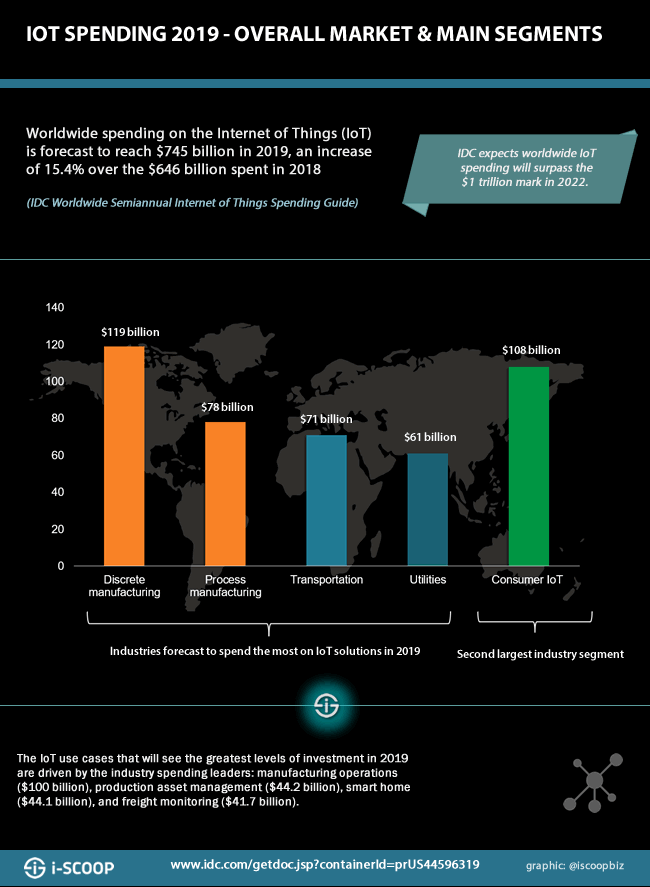
By way of comparison: in the forecasts for IoT spending in 2018, consumer IoT ranked fourth from a spending viewpoint after manufacturing (process and discrete combined), transportation and utilities, respectively.
The industries with the highest compound annual growth rates (CAGR) over the forecast period (2017-2022) are insurance, federal/central government, and healthcare.
Consumer IoT 2019: the consumer is connecting – with smart home as main use case category
Although our key focus is not consumer IoT it’s clear we need to start with it for 2019. Henceforth we’ll also start treating some segments in IoT – certainly in consumer IoT – separately as our focus is Industrial IoT and Industry 4.0 and we have dedicated sections on some consumer-related use case categories such as smart home (and smart buildings overall).
If we take the costs of hardware, software, connectivity and services in the consumer IoT segment into account the predicted $108 billion clearly shows that consumers find their way to the Internet of Things.
Smart home is the main use case category, forecast to reach $44.1 billion. Next follow personal wellness and connected vehicle infotainment. So, IoT at home, for a ‘healthier’ life and for fun and entertainment, not just at home but also on the road: that seems to be the main consumer picture for now.
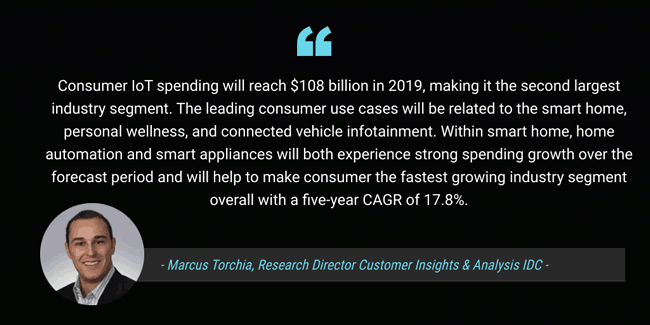
Within smart home, home automation and smart appliances are expected to experience strong spending growth over the forecast period (2017-2022).
Consumer IoT is also the fastest growing industry segment overall in the forecast period with a CAGR of 17.8% says Marcus Torchia, research director, Customer Insights & Analysis, at the occasion of the announcement of the 2019 Worldwide Semiannual Internet of Things Spending Guide.
In practice there are of course overlaps between the categories the industry invented, from consumer IoT to enterprise IoT, industrial IoT, healthcare IoT and whatnot. The smart home category is one example of a broad category. In one of its mentioned areas, home automation, the services segment includes expert firms and integrators whom you might find in both the high-end residential market and the non-residential market, for example with a background in light control and room control whereby a room can also be a meeting room in an office or even a plant.
For consumers, access to data is changing how they are informed about the status of households, vehicles, and family members as well as their own health and fitness (Carrie MacGillivray)
Moreover, aside from typical cross-industry use cases and categories of devices, it’s clear that from a business perspective IoT is about connecting quite some dots too. Take insurance or digital health, for instance. These and other sectors/players try to connect parts of their business/activities to data from consumers using IoT devices. It can be for premiums, plans and promotions but also simply because of better care, certainly in specific healthcare cases (e.g. remote monitoring). We’ve discussed this previously with for instance the usage of personal health data, real-time adjustments to care plans and the shift from passive to active patient engagement, to zoom in a bit on healthcare.
Anyway, it’s clear: the consumer appears to want to be connected and it starts at home. As Carrie MacGillivray, vice president, Internet of Things and Mobility at IDC, puts it in the announcement of the January 2019 update of the Worldwide Semiannual Internet of Things Spending Guide: “for consumers, access to data is changing how they are informed about the status of households, vehicles, and family members as well as their own health and fitness”.
IoT 2019 spending forecasts: looking back and ahead
Back to IoT spending in general. So, worldwide spending on IoT in 2019 overall is forecast to reach $745 billion. That’s an increase of 15.4% compared to 2018 when a total of $646 billion was spent.
This means that in 2018 IoT spending was lower than expected previously too (the forecast was $772.5 billion for 2018 per an update end 2017). We mention it because it indicates that the IoT market so far has been growing slower than anticipated which can be attributed to many factors. We also see this at other research firms (we don’t compare them given different approaches).
However, while the reasons for this slower growth are still there and some have gained far more attention (IoT security being an essential one with a lot of focus on industrial cybersecurity, more below), other developments can give the market a boost – not just on the level of technologies.
Perhaps what you want to remember is that throughout the 2017-2022 forecast period IDC expects that worldwide IoT spending will maintain its double-digit CAGR and surpass the $1 trillion mark in 2022.
This is two years later than was previously expected but a clear sign that expectations remain high. Carrie MacGillivray doesn’t doubt the potential for the future and next stages too much either, emphasizing that “the next chapter of IoT is just beginning as we see a shift from digitally enabling the physical to automating and augmenting the human experience with a connected world”.
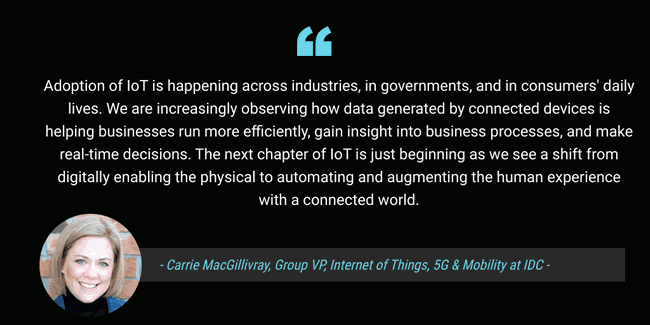
IoT remains key in digital transformation, security remains a key issue
We’ve tackled some of the factors impacting investment decisions of executives regarding IoT deployments before. Security is one, skills are another, finding compelling use cases for IoT with clear KPIs to gauge ROI is a challenge, the list goes on.
Still, IoT continues to rank very high (often on the first spot) when execs are asked about the ‘technologies’ they see impacting their business most and/or in which areas they intend to invest most in the next years as well as in 2019. IoT remains important for digital transformation as digitally enabling the physical offers so many new opportunities and possibilities leveraging data from material things for ample reasons.
So…to be continued although it’s clear that security and regulation will play an important role. In fact, cybersecurity is both a driver for IoT investment and a challenge that goes hand in hand with the challenges we increasingly see around digital trust – and the attempts to address them. Yet, it remains a factor of uncertainty, not in the least because IDC expects that by 2021 more than half of G2000 companies will have modernized and IoT-enabled their industrial control systems without addressing cybersecurity or public safety concerns, prompting regulators to legislate. That was one of the top 10 worldwide IoT 2019 predictions IDC made end 2018 (you can read all ten here).
Carrie MacGillivray also covered some of the main IoT deployment hindrances in a post sharing some early insights from IDC’s global IoT decision maker survey end 2018.
Wondering what the reasons are why organizations don’t invest in IoT indeed showed security and privacy concerns as major hurdles, along with a lack of budget bubble to the top. Further, not fitting with the company strategy or an unclear ROI kept organizations from investing which resulted in a focus on the need to demonstrate ROI in the FutureScape IoT webcast later on and in the graphic below.
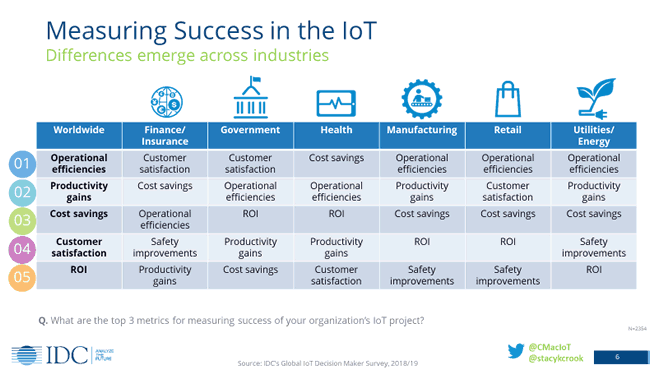
IoT 2019 spending across various industries: the leaders, the fastest growers and the use cases
A quick overview of spending patterns for the leading industries with the main use cases and some fast-growing industries and use cases.
Manufacturing and IoT in 2019
In manufacturing (discrete and process) IoT spending will mainly go to solutions that support manufacturing operations and production asset management.
The highest levels of investment for 2019 are for manufacturing operations with $100 billion while production asset management is the second IoT use case in manufacturing with $44.2 billion predicted for 2019.
As a reminder: spending on IoT solutions in discrete manufacturing is expected to reach $119 billion in 2019 and in process manufacturing IoT solutions will be good for a total spend of $78 billion.
Discrete manufacturing and process manufacturing are by the way the two industries that will invest most in digital transformation in 2019 according to another IDC spending guide – from April 2019 – with respectively $221.6 billion and $124.5 billion and with the top DX spending priority being smart manufacturing, “supported by significant investments in autonomic operations, manufacturing operations, and quality”.
Transportation – freight monitoring and fleet management get company
Spending in the transportation industry follows closely behind process manufacturing with an expected $71 billion on IoT solutions in 2019.
Here the main use case is freight monitoring that represents more than half of IoT 2019 spending in transportation with a forecast of $41.7 billion. Fleet management ranks second.
There is also a transportation use case that will grow fast during the forecast period (2017-2022) and even leads the top 5 of use cases through 2022 on a CAGR basis: airport facility automation with 22.6%.
Freight management by the way features as a top digital transformation use case (which IDC defines as ‘discretely funded efforts that support a program objective’) in the earlier mentioned DX spending guide with an expected investment of $41 billion in 2019.
Utilities – smart grids and grid management
Utilities are forecast to spend $61 billion on IoT solutions in 2019. IoT spending in the utilities industry continues to be dominated by smart grids for electricity, gas, and water.
Yet, in utilities as well there is a use case that is among the fastest growing ones throughout the forecast period: electric vehicle charging ranks second in that top 5 with a CAGR of 20%.
Among the digital transformation use cases seeing DX investments of over $20 billion (so, not just IoT) in 2019 we also note intelligent and predictive grid management for electricity.
Other industries and use cases to watch
As mentioned earlier the industries with the highest CAGR over the forecast period regarding IoT spending are insurance, federal/central government, and healthcare.
The respective compound annual growth rates:
- 17.1% for insurance,
- 16,1% for federal/central government and
- 15.4% for healthcare.
On the use case front we note, on top of those mentioned in manufacturing, transportation and utilities, following use cases from the CAGR perspective:
- In the category ‘resources’ there is agriculture field monitoring with 19.8%.
- Healthcare is expected to see an increase of 19.2% in bedside telemetry.
- Retail closes the top 5 with 19.2% for in-store contextualized marketing.
IoT 2019 spending per solution ‘component’: hardware, software, connectivity and services
As usual IDC also splits up IoT spending in hardware, software, connectivity and services.
IoT services is poised to be the largest category from a spending perspective in 2019 with organizations expected to spend $258 billion on these services.
They include traditional services (IT, installation, etc.) and non-traditional device and operational services. Moreover, during the forecast period spending on services will continue to grow faster than IoT spending overall with a CAGR of 14.2%.
IoT hardware, a vast category including IoT modules, sensors but also all the gear needed in an IoT solution, such as IoT gateways, ranks second with an expected spending of $250 billion whereby over $200 billion goes to modules/sensors.
In its ‘IDC FutureScape: WorldWide IoT 2019 Predictions‘ from end 2018 IDC predicted a strong growth on the somewhat longer term for edge gateways as it expects that 40% of initial IoT data analysis will occur at the edge by 2022 (edge computing and fog computing become more important).
IoT software should total $154 billion in 2019, yet as has been the case in previous years, IoT software is the fastest growing IoT technology category with now an expected CAGR of 16% in the forecast period (followed by services).
Here we should of course mention IoT platforms that are the foundation of IoT success as Carrie MacGillivray put in in the ‘IDC FutureScape: WorldWide IoT Predictions 2019’ webcast. IDC expects that by 2020, 70% of organizations will leverage commercial IoT platforms to develop and deploy IoT applications, and more than 50% will have multi vendor IoT platform environments.
IoT connectivity spending finally will total $83 billion in 2019. IDC hasn’t mentioned IoT connectivity in its top 10 IoT 2019 trends but it’s clear that in this segment, even if it’s the smallest from a spending perspective, a lot is happening and about to happen.
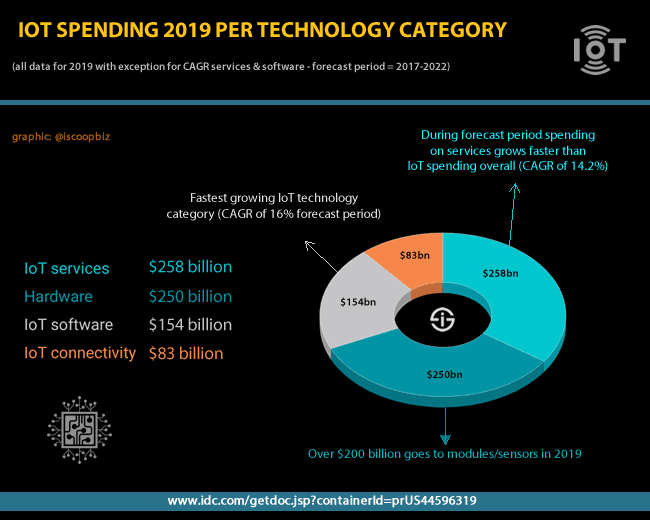
On a connectivity level, over the next years there will be the gradual impact of 5G which IDC tackles in other reports (as it does with connectivity evolutions) and of course there are also the roll-outs of cellular IoT networks based on the 2016 3GPP standards across the globe whereby NB-IoT and LTE-M come on top of existing LPWAN standards and the ecosystems of players like the LoRaWAN ecosystem and Sigfox.
For operators the challenge with NB-IoT and LTE-M is related with margins and ARPU as discussed in our interview with AllThingsTalk and for 5G and IoT it’s still relatively early although the main initial use cases are pretty well known but the players in the market, certainly the operators that invest(ed) a lot (and it’s not just about the licenses) have work ahead before really benefiting from their deployments (and some of the main use cases for 5G and IoT are far from ready anyway).
Also, in the consumer segment new standards are emerging which is food for a separate article.
IoT software: increasing usage of the cloud and coming dominance of vertical IoT platforms
In a June 2019 IoT spending update IDC focuses on two additional trends in IoT software as it added additional possibilities for its clients to segment further (the new ‘Deployment Type’ segmentation from the quote):
- The dominance of vertical industry IoT platforms. Over three quarters of all spending on IoT platform software which IDC defines as ‘middleware that provides the device management, connectivity management, data management, visualization, and applications enablement for connecting IoT endpoints‘, are expected to go to software packages integrating and supporting devices, applications, data schemas, and standards of a single industry. Thus: vertical IoT platforms that are tailored to the needs of e.g. industrial markets (IIoT platforms) and more (there are already platforms for specific IIoT niches such as buildings, energy, manufacturing and for smart cities etc.).
- The rise of cloud deployments for IoT software. This includes applications, analytics software, and IoT platforms with nearly one third of IoT software spending expected to go toward public cloud deployments by 2023 (in 2018 this was less than 20%).
IoT 2019 spending highest in US and China – fastest growth for Latin America
Finally, IDC also looks at IoT 2019 spending from a regional perspective. Here it’s perhaps most noteworthy that the countries that will see the fastest IoT spending growth over the 2017-2022 forecast period are all in Latin America.
Mexico leads with a CAGR of 28.3% and is followed by Colombia (24.9% CAGR) and Chile (23.3% CAGR). It won’t come as a surprise that the US and China are expected to be the largest IoT spenders in 2019 at $194 billion and $182 billion respectively.
Next come Japan ($65.4 billion), Germany ($35.5 billion), Korea ($25.7 billion), France ($25.6 billion), and the UK ($25.5 billion).
In an IoT spending forecast update released in June 2019 (key takeaways below) IDC states that the US and China will account for roughly half of all IoT spending throughout the forecast period (now including 2023), followed by Western Europe and Asia/Pacific (excluding Japan and China). The regions that will see the fastest IoT spending growth still include Latin America but also the Middle East and Africa with CAGRs of 23.1% and 19.5% respectively.
Key takeaways from the June 2019 IoT spending update from IDC
On June 13, 2019, IDC announced a new update to its Worldwide Semiannual Internet of Things Spending Guide with some slight changes, mainly for 2019.
- Per the updated forecasts, IoT spending for 2019 is now expected to be $726 billion (instead of $745 billion).
- The $1 trillion mark is still expected to be passed in 2022, with ‘steady’ adoption of IoT resulting in a $1.1 Trillion in 2023.
- Discrete manufacturing, process manufacturing and transportation are expected to account for nearly a third of worldwide spend total in 2023.
- The main use case categories in manufacturing will be manufacturing operations while in transportation it’s mainly freight monitoring.
- In 2019 IDC still expects the consumer market to be the second largest source of IoT spending with smart home and connected vehicle use cases in the lead.
- Consumer spending is forecast to overtake discrete manufacturing and become the number one source of IoT spending by 2023.
- The five-year compound annual growth rate (CAGR) across all industries is 16.8%.
More than three quarters of all spending on IoT platform software will go toward software packages that integrate and support devices, applications, data schemas, and standards of a single industry. (IDC, June 2019)
IDC’s Carrie MacGillivray in a comment on the June 2019 IoT spending update: “while organizations are investing in hardware, software, and services to support their IoT initiatives, their next challenge is finding solutions that help them to manage, process, and analyze the data being generated from all these connected things.”
It’s a quote that comes at exactly the right time as many organizations have difficulties in leveraging data overall and often the data maturity is missing to do more with data, including data from connected devices. Data analytics skills and getting data management right is essential and helping organizations to do so is key for IoT companies and certainly companies in industries where IoT is now omnipresent. Fortunately many integrators have understood this better than some vendors as they adapt their business models and don’t sell ‘xyz’ solutions anymore but focus on helping their customers leverage data from connected devices as a soon to be published interview will show.
Below is a a graphic from the IDC update showing the top IoT use cases based on 2023 market share.
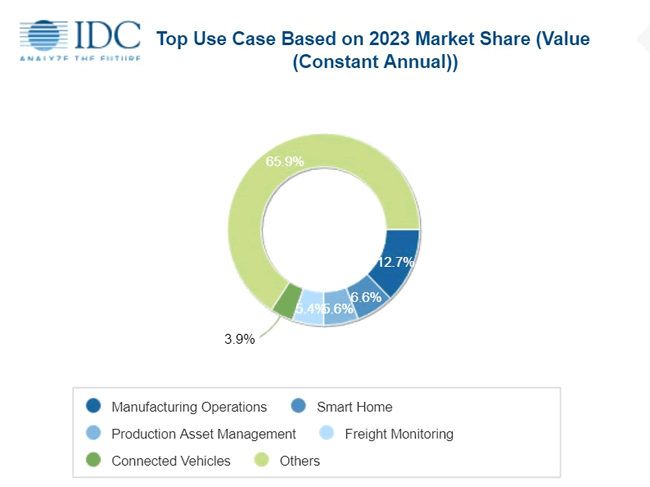
The Worldwide Semiannual Internet of Things Spending Guide from IDC.
All pictures courtesy of their mentioned owners

